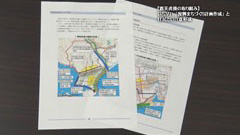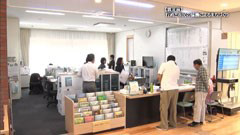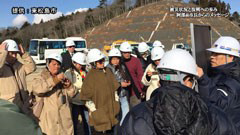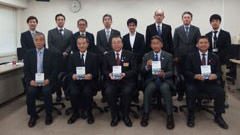What is the reason for accelerated recovery.
On March 11, 2011, the Great East Japan Earthquake that brought unprecedented damage occurred. More than 1100 inhabitants died and 97% of the houses were damaged in Higashimatsushima City. However, Higashimatsushima City announced, "Restoration and Reconstruction Guidelines" which was the basic policy of the administration in April of the same year just one month after the earthquake disaster. Furthermore, in December eight months after that, it had formulated the "Reconstruction Town Planning Plan" showing the group relocation destinations of victims who lost their homes. The reason for accelerated reconstruction was in the community development of Higashimatsushima City which had been working on from before the earthquake disaster.

"Reconstruction Town Planning Plan" showing the group relocation destinations.
"Power of residents" that worked in emergency

Civic center operated by the residents.
In April 2005, Higashimatsushima City was born by the merger of two towns located about 30 km northeast from Sendai. What the city initially worked on was the community building. The new city was in a situation where it had become difficult to provide well-rounded services in a widened area, with decreasing financial resources due to declining birthrate and aging population. Creating community was indispensable so that residents would do what they could by themselves rather than waiting for the government, and would promote the town planning which they could help each other. In 2009, the public hall system was abolished and local autonomous organizations which was composed of the resident representatives were born in 8 districts. An operating system to manage their civic center by themselves was established.
The power of residents based on "self-help" and "mutual assistance" that had been cultivated before the earthquake in this way worked in the process of emergency response and restoration immediately after the disaster. Residents in the inland areas where the damage was relatively small visited evacuation centers filled with many victims, worked on cooking, distributing supplies, checking missing persons, etc. Also, when "Reconstruction Town Planning Plan" was formulated, it was started not by discussion on the desk but consulting the residents who were familiar with the area.

Higashimatsushima residents preparing hot meals for victims
Higashimatsushima City, that had been promoting a system in which the administration and citizens collaborated, had made remarkable reconstruction through the wisdom and devotion of the residents, which attracted attention as "a top runner of reconstruction".
Reconstruction model disseminating all over the world

Inspection team from Philippines
The lessons and know-how which Higashimatsushima City learned would be able to be shared widely by utilizing this JICA-Net multimedia material. It is expected to help not only utilize for disaster prevention and recovery but also promote regional autonomy and emergency measures in depopulated areas in terms of the ways of civic cooperation in areas with reduced population and efforts to address new issues emerging in the process of rebuilding. This movie shows the disaster recovery training for government officials in developing countries by collaborating with JICA and a general incorporated association called HOPE [Higashimatsushima Organization for Progress and Economy, Education, Energy], It could be used for international education at local elementary and junior high schools as an example of international cooperation and regional revitalization through disaster prevention.
Hideo Abe, a former mayor of Higashimatsushima City, who lead the reconstruction continued to appreciate the generous support received from domestic and overseas, and said, "We should make a model of reconstruction to return the favor." I hope that reconstruction of Higashimatsushima City achieved by the warm support from domestic and overseas and power of residents would be disseminated as a model of disaster prevention and reduction, town planning in disaster area and it would contribute to improve awareness of disaster prevention in the world.

Higashimatsushima citizen who worked for revival and JICA Staff in the ceremony of presentation of the material
Atsutoshi Hirabayashi
Senior Adviser [Community Development / Reconstruction Assistance]
Infrastructure and Peacebuilding department
*The Material(s) mainly applied
Higashimatsushima City's Reconstruction Efforts from the Great East Japan Earthquake
Higashimatsushima (HM) City suffered 1,110 earthquake-related deaths and 97 percent of all homes in the city were damaged in March 2011. HM City formulated Guidelines for Recovery and Reconstruction a mere month, in April 2011 after the earthquake and formulated Reconstruction plan in December. This material overviews "Citizen collaborative community building" initiative and city government's efforts for quick recovery.




scroll